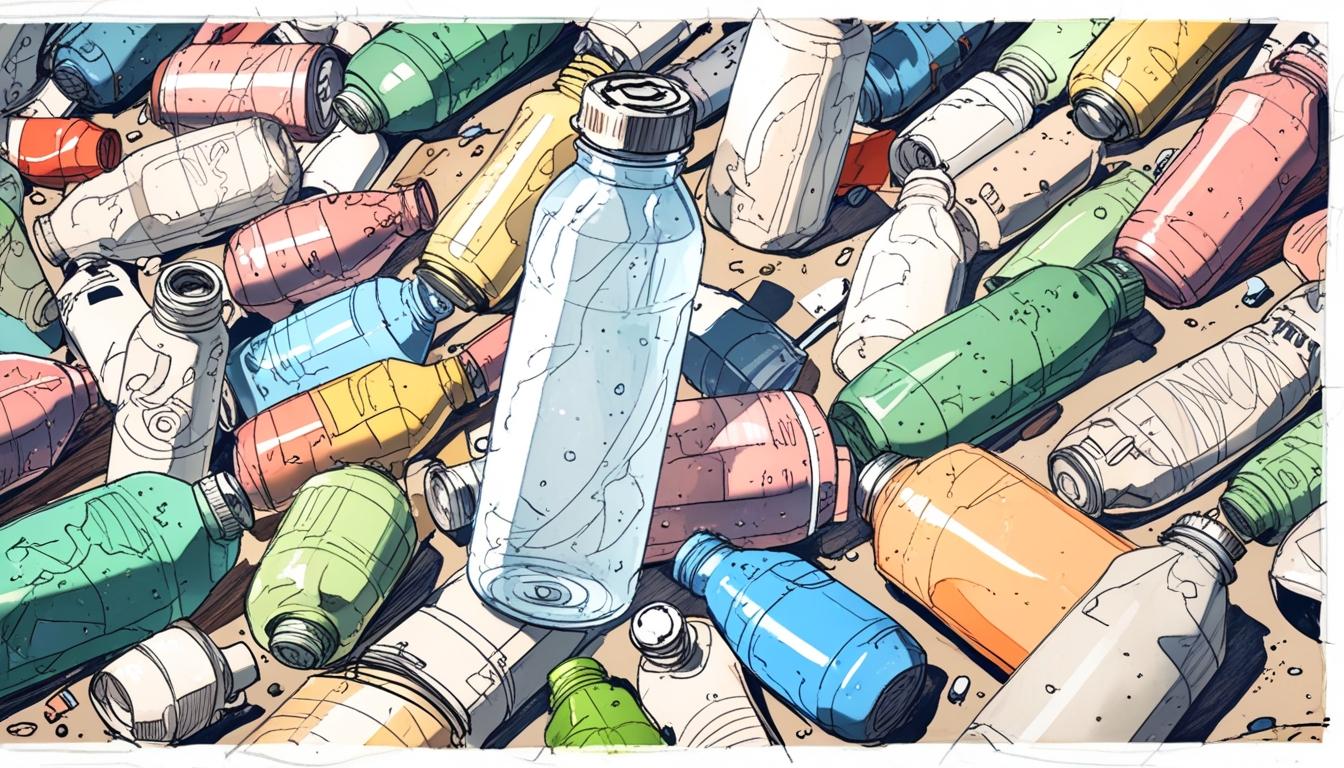The booming popularity of reusable water bottles driven by social media and sustainability concerns has led to soaring sales, but experts warn that production impacts and consumer habits may undermine genuine environmental benefits.
The surge in popularity of reusable water bottles, particularly from brands like Stanley, Owala, and HydroFlask, has been fuelled by social media trends and a growing consumer focus on sustainability. In recent years, searches for “Stanley Cup,” for example, skyrocketed from approximately 30,000 per week to over 600,000. This phenomenon reflects a broader societal shift that has seen sales of reusable bottles in the United States grow from $1.5 billion in 2020 to $2 billion in 2022. Despite this positive trend, the environmental impacts of such consumption are proving to be complex and potentially detrimental.
As society moves away from single-use plastics, which can take up to 1,000 years to decompose and contribute to severe environmental pollution, the appeal of reusable alternatives is understandable. However, both the manufacturing and the consumer habits associated with these products raise concerns about whether the actual impact is as beneficial as hoped. Producing glass and stainless steel bottles requires significant energy and raw materials, potentially resulting in a greater carbon footprint than that associated with single-use bottles. Some experts argue that the production of reusable bottles might emit more greenhouse gases than their single-use counterparts, calling into question the true sustainability of this trend.
The issue is compounded by a growing culture of collection and fashion around these products. Social media platforms have amplified the visibility of unique and limited-edition designs, leading consumers to amass multiple bottles for aesthetic appeal. This trend highlights a fundamental problem: even as individuals opt for reusable bottles, many continue to rely on single-use options out of habit or convenience. Carrie Frost, a nurse from Colorado, points out that even those with several reusable bottles may still purchase plastic ones, which undermines the environmental benefits of switching to reuse.
Moreover, while the motivations behind choosing reusable bottles often centre on reducing plastic waste, data reveals an alarming contradiction. The total number of plastic bottles sold in the U.S. reached 11.3 billion in 2022, suggesting that the shift toward reusables does not automatically correlate with a reduction in overall bottle consumption. This dangerous trend has given rise to the argument that consumers may simply be exchanging one form of consumption for another, thereby diluting the positive environmental impact intended by choosing reusable bottles.
Indeed, the environmental consequences of single-use plastics are dire, with many bottled water products showing contamination, as nearly 93% of tested samples contain microplastics. By contrast, reusable bottles present a viable alternative, as they could significantly cut down on the demand for plastic production and its accompanying pollution. However, it remains essential to acknowledge that simply switching to reusable options does not exempt consumers from the responsibility of mindful consumption.
Across Europe, the increasing regulatory pressures against plastic use, aiming to mitigate waste and promote healthier lifestyles, have also led to a resurgence in demand for reusable bottles. The trend mirrors that observed in the United States, raising the question of whether the increased focus on health, style, and sustainability is enough to drive meaningful change in consumer behaviour globally.
In summary, while reusable water bottles provide a promising solution to the single-use plastic crisis, the environmental footprint associated with their production and the compulsion to collect and replace trendy items poses a real threat to their intended sustainability benefits. Without a fundamental shift in consumer attitudes and behaviours, the environmental advantages of reusable bottles may remain compromised by the very trends that promote their use. Thus, fostering greater awareness and encouraging consumers to genuinely integrate sustainability into their daily choices is crucial for the future of both individual health and the planet.
Reference Map
- Paragraphs 1, 2, 3, 4, 5, 6, 7
- Paragraphs 2, 4, 5
- Paragraphs 1, 3, 4
- Paragraphs 2, 5
- Paragraphs 2, 4
- Paragraphs 2, 6
- Paragraphs 1, 5
Source: Noah Wire Services
- https://thesoutherneronline.com/99482/comment/trending-water-bottle-overconsumption-poses-severe-environmental-threat/ – Please view link – unable to able to access data
- https://www.sierraclub.org/santa-barbara-ventura/blog/2024/10/climate-watch-switching-reusable-water-bottles-and-cups – This article discusses the environmental impact of single-use plastic water bottles, highlighting that they can take up to 450 years to decompose, releasing contaminants into soil, water, and air. It also notes that 93% of tested bottled water samples contain microplastics, posing health risks. The piece advocates for switching to reusable water bottles and cups to mitigate these environmental and health concerns.
- https://enviroliteracy.org/how-do-reusable-water-bottles-help-the-environment/ – This article examines the environmental benefits of reusable water bottles, emphasizing their role in reducing plastic waste, conserving resources, and decreasing carbon emissions. It highlights that billions of single-use plastic bottles are produced annually, contributing to pollution and resource depletion. By opting for reusable bottles, consumers can significantly reduce the demand for plastic production and its associated environmental impacts.
- https://lavie.bio/en/the-environmental-impact-of-plastic-water-bottles-and-how-to-avoid-it/ – This article outlines the environmental consequences of plastic water bottles, including ocean pollution, greenhouse gas emissions, and the depletion of natural resources. It notes that plastic bottles can take up to 1,000 years to decompose, releasing toxic chemicals into the environment. The piece suggests reducing the use of single-use plastics and opting for reusable alternatives to mitigate these impacts.
- https://waterexotic.com/environmental-impact-of-water-bottles/ – This article discusses the environmental impact of water bottles, particularly plastic ones, highlighting issues such as pollution, resource depletion, and greenhouse gas emissions. It notes that plastic bottles can take up to 1,000 years to decompose, releasing toxic chemicals into the environment. The piece advocates for reducing the use of single-use plastics and opting for reusable alternatives to mitigate these impacts.
- https://ceh.org/yourhealth/reusable-bottles-better-than-bottled-water/ – This article highlights the environmental and health benefits of using reusable water bottles over single-use plastic bottles. It points out that only 32% of plastic water bottles are recycled, with the rest ending up in landfills or as litter, contributing to environmental pollution. The piece also notes the lack of standards for bottled water, which can contain contaminants, making reusable bottles a safer and more sustainable choice.
- https://en.wikipedia.org/wiki/Bottled_water – This Wikipedia article provides an overview of bottled water, including its history, production, and environmental impact. It notes that global bottled water consumption crossed the 3 billion hectoliter threshold in 2014, with per capita consumption rising to 50.1 liters in 2017. The article also discusses the environmental concerns associated with bottled water, such as resource wastage, transportation emissions, plastic litter, and damage to aquifers.
Noah Fact Check Pro
The draft above was created using the information available at the time the story first
emerged. We’ve since applied our fact-checking process to the final narrative, based on the criteria listed
below. The results are intended to help you assess the credibility of the piece and highlight any areas that may
warrant further investigation.
Freshness check
Score:
8
Notes:
The narrative discusses data up to 2022 and current social media trends, indicating recent content; no references to outdated figures or individuals found. No indication that this is a recycled piece or a press release. The use of up-to-date statistics and references to ongoing trends in both the U.S. and Europe supports a relatively fresh context.
Quotes check
Score:
7
Notes:
One direct quote from a nurse named Carrie Frost is present, but no independent verification or earliest source of this quote was found online, suggesting it could be original or first reported here. This absence lowers the verification score but does not imply unreliability, rather possible originality.
Source reliability
Score:
5
Notes:
The narrative originates from The Southerner Online, which is a lesser-known local publication without clear indication of editorial standards or reputation comparable to major reputable outlets such as BBC or Reuters. This limits certainty about reliability, though no clear misinformation or sensationalism is evident.
Plausability check
Score:
8
Notes:
The claims about environmental impacts, rising sales figures, presence of microplastics, and consumer behaviour around reusable bottles align well with known industry and environmental data trends. The nuanced view on production impact and consumption habits is plausible and reflects ongoing discussions in sustainability fields. However, no specific study references or expert citations reduce direct verifiability.
Overall assessment
Verdict (FAIL, OPEN, PASS): OPEN
Confidence (LOW, MEDIUM, HIGH): MEDIUM
Summary:
The narrative presents current and believable information regarding reusable water bottles’ environmental impact, supported by recent statistics and trends. The direct quote appears original but uncited, and the publication’s lesser-known status restricts confidence. The information is plausible and generally aligns with known data but would benefit from stronger sourcing to pass fully.













